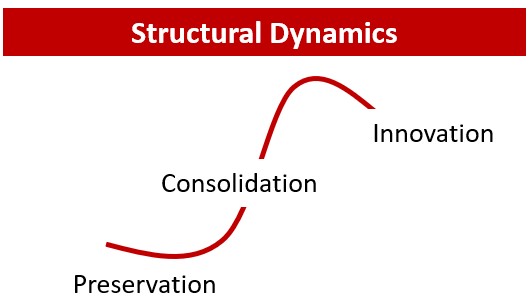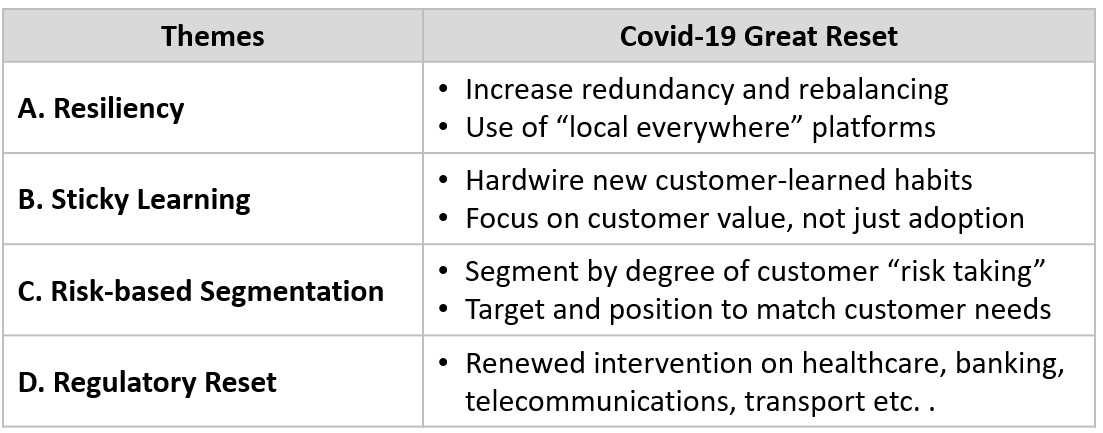Podcasts are a great life hack, a low time-cost way to learn something. Recently, I’ve been enjoying the Goldman Sachs’ Exchanges podcast even though I am not a finance wonk. It has an interview format. The heads of different Goldman Sach’s business lines – foreign exchange, investment banking, corporate bonds – interpret the current market volatility in plain English. It’s surprisingly direct and easy to understand. It’s like getting the inside scoop from 20+ year financial market warriors who spend all day tussling with clients / competitors, trying to “get some alpha.” For those strategy-minded, start with June 9, 2020: The Great Reset.
This podcast is 23 min long and Steven Strongin, previous head of Goldman Sachs’ global research, thinks about the economic drivers that will shape industry and competition, post-Covid. It’s pretty big-think. He argues for 3 macro phases where companies and investors optimize for different things (preservation, consolidation, innovation). It’s a pendulum swinging between incumbents and new entrants. A Schumpeter pendulum, creating and destroying.
The original paper was published May 27, 2020 here.
The Great Reset: A framework for investing after Covid-19
As the name implies, Covid-19 is more than a “shock” to the economic system, or an “unprecedented recession”. Let’s not minimize this. Pandemic health crisis. Full-stop. Global economic coma. Full stop. This is a full reset. Think: <CTRL> + <ALT> + <DELETE> of industry dynamics, consumer behavior, regulatory thinking, monetary supply, uh, a lot of things.
Covid-19 is a “rule changing event” so that any “copy/paste” strategies of the past eventually dead-end. Think S-curves. Things work and then they don’t. Each stage will be quite different from the previous one. Sounds a bit unstable, right? Yes, and it’s also massive opportunity. If I were to draw it out, it might looks like this. With critical pivots between each stage.

Strongin outlines a few themes which will accelerate, jerk, pull the progress of companies through these phases. As a consultant, really appreciate how Strongin puts things into a few buckets, shows the logic / assumptions – making it easy for us (the readers) to see where we agree or disagree with his thinking. It feels like he’s an MBA candidate working through a case.
“Supporting business models that work, and starving those that don’t, is how economies adapt to new circumstances. . . The idea is to separate the consistent drivers of change from the structural environment that determines the best way to change at a given moment.”
Key point you will see pop up again. Sometimes, companies get lucky. They have a temporary advantage because of circumstance (e.g., the right distribution footprint, or supplier network). This is not necessarily a sustainable competitive advantage, so they need to watch out for the industry pivots. Strategy class students – think Intel, inflection points. Achtung.
1. Preservation
No mystery here. If you are an airline and your planes are grounded for a few months – you are in survival mode. The same holds true for investors and governments. It’s about balance sheet defense. In the first few months, it’s impossible to reliably create a baseline. After all, who knows? The best strategy is to build up cash, stay flexible and “live to fight another day.”
This too, completely makes sense. . . until it doesn’t. At what point do leaders stop playing defense and start preparing for the medium term? When does the patient stop bleeding and we can start with the treatment? First inflection.
2. Consolidation
No surprise, that customers (and investors) will gravitate to the survivors. Perhaps the better capitalized (read: rich) companies will survive. Maybe the winners will be the profitable ones. Those who are not over-leveraged. Or too-big-to-fail companies will get government help.
Maybe some will just be lucky.
During the consolidation phase we will see competitive advantages be self-reinforcing. At some level, it will simply be enough to be ahead . . . reshuffling share among existing technologies and companies rather than actual new things.
With near-zero interest rates, and a record amount of corporate bond fund-raising, there will definitely be a wave of M&A and PE firm acquisitions in second half of 2020, and 2021. Pop quiz, what % of the publicly-traded companies in the US, are profitable? As of July 12, 2020:
- 7,519 publicly-traded companies on the three US exchanges
- 2,290 (30%) of them have a positive net margin
So there are 70% of US companies who have negative net margin. This is not the same as cash flow, but if you stay with the exercise, there are 184 companies with market cap between $2B-$10B (not small companies) that are unprofitable, and vulnerable for a roll-up or shut down.
3. Innovation
Once life reaches some steady-state (cynics chime in: when is that, exactly? Florida just hit 15,000+ new cases today), consumers / citizens / companies will ask for different things. Of course, when and how is not clear. However, we know this will create opportunity for more nimble challengers not burdened by legacy assets and liabilities. What made you strong THEN (consolidation phase), can make you weak LATER (innovation phase).
The CEO challenge: By industry, by end-segment, how quickly will we go through the preservation / consolidation / innovation phases? When is the inflection point? Some recent data points:
- Boeing raises $25 Billion in corporate bonds (Preservation)
- Just Eat Takeaway will acquire GrubHub for $7 Billion+ (Consolidation)
4 Themes: Resiliency, Learning, Risk, Regulations
A. Resiliency
For many years, we took the global supply chain for granted. We went to the store and they had stock. Then Covid-19 hit. No toilet paper, no masks, no chicken. What?
The system was too cost optimized and not sufficiently optimized for reliability under stress. Supply lines could be long, complex and rife with single points of failure as long as they were cheap. After COVID-19, firms and consumers will place greater value on reliability
During the initial preservation / consolidation phase, the incumbents will win. They are the ones with suppliers, trucks, warehouses across the global. They can “re-balance” the most quickly.
These global, but local-everywhere systems, have the advantage of being able to deal with global disruptions by going local and dealing with local disruptions by load balancing in other regions in ways that extended global supply chains and local suppliers cannot.
That said, the pendulum will naturally swing too far. Companies will become overly vertically integrated through M&A and expansion into non-core areas. The average age of a US publicly-traded company is less than 20 years. How to stay resilient?
B. Sticky Learning
Yes, old (adults) can learn new tricks. Raise your hand if you’ve used ZOOM, MS Teams, and Skype more in the last 3 months than the previous 3 years? We spend our time and money differently. Some of that will stick with us. Not all changes are permanent – but you’d be surprised how different retail, restaurants, and education will look in your future. If we are learning new ways to working, buying, and socializing, what does that mean for business?
- The technology adoption life cycle may be shortened in some categories. We ‘crossed the chasm’ in many ways. This means the profitable early majority are now the target.
- Many of these disruptive innovation (less for less) are not as good as IRL (in real life) version, and yet, we are accustomed to the cheaper, “it’s good enough” version.
- The world is learning new habits and this Covid-19 lifestyle will likely be necessary for another 12+ months. As a previous student said, this is Zero-based budgeting of your life.
COVID-19 has taught those corporations that in many cases, the control they thought they had was an illusion and that their vendors were in a better position to innovate than they themselves were. Companies have been forced to understand what actually is core to their business, which has turned out to be a much shorter list than they thought pre-COVID-19.
C. Risk based segmentation
Some people are risk-averse, while others are risk-takers. Yes, we know that. . . But wow, we are seeing that in full-color during this crisis. Some people are barricaded at home, while others are freely congregating without masks. <<Actually, it’s kind of tragic. A lack of shared values, and consistent public health communications. Grrr.>> For companies, the questions:
- How will you approach your risk-averse vs. risk-taking customers?
- How will you design your offices, warehouses, and standard operating procedures?
- Will you forgo some business because they are too risky / too risk averse?
D. Regulatory reset
We – the government, industry, individuals – all felt unprepared for the Covid 19 crisis. As such, the government will likely react with regulation across healthcare, hospitals, banking, transportation, leisure activities etc. . . No surprise, even libertarians begrudgingly will agree that the governments (could have) played a critical role coordinating a public health response and preventing an economic collapse.
This will almost certainly act to further reinforce the consolidation process as it pushes the system to reinforce what had worked and punish the failures. In the second phase, the regulation shift will largely be about the consolidation itself—the power concentration, the lack of competition, the economic imbalances that will accompany that increase in concentration. This will likely kick off a regulatory wave of supporting new entry and holding back the consolidators.
A lot of words above – but the message is that governments will likely promote the “winners” during the consolidation phase, then swing the other way, and try to break-up what they THEN see as over-consolidation of oligopolies and monopolies. The pendulum.
Goldman Sachs highlights 4 themes they believe will most affect all industry structures.

What themes do you expect to see in the next 10 years?

This is such a fantastic, and structured way of presenting some big ideas. Thanks for sharing!
Thanks for reading. . .also, great guitar and piano compilation.